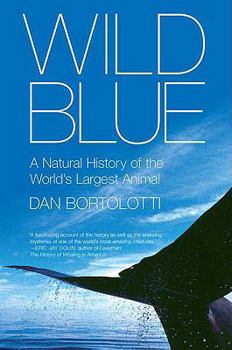Wild Blue: A Natural History of the World's Largest Animal
Select Format
Select Condition 
Book Overview
The blue whale holds the title of largest creature that has ever lived, and it may also be the most mysterious. The biggest blue whales can outweigh every player in Major League Baseball and the... This description may be from another edition of this product.
Format:Hardcover
Language:English
ISBN:0312383878
ISBN13:9780312383879
Release Date:October 2008
Publisher:Thomas Dunne Books
Length:315 Pages
Weight:1.00 lbs.
Dimensions:1.1" x 6.1" x 8.5"
Related Subjects
Animals Conservation Fauna Mammals Marine Life Nature Nature & Ecology Oceans & SeasCustomer Reviews
3 ratings
A superb contribution to natural history
Published by Thriftbooks.com User , 15 years ago
Wild Blue is simply a great book in every way. It introduces us to a mammal we know surprisingly little about, despite said mammal's status as the largest creature ever to live on Earth. The author is outstanding at explaining cetacean biology, scientific principles, technology, and so on without ever losing his sense of wonder. He also introduces us to the key figures in blue whale research and lets us know what motivates them. Wild Blue is scientifically exacting yet always accessible to the nonspecialist reader like myself. That's a very difficult tightrope for any author to walk, and Bortolotti never loses his balance. This will stand for a long time as the definitive work on its subject. Matt Bille author, Shadows of Existence: Discoveries and Speculations in Zoology (Hancock, 2006)
Great Book!!!!
Published by Thriftbooks.com User , 15 years ago
Excellent book on the Blue Whale. That being said, there are very few books on the Blue Whale, so lets hope Wild Blue is just the beginning of many focusing on this magnificent whale. Great job Dan Bortolotti, thanks.
Finally A Good Book on Blues
Published by Thriftbooks.com User , 15 years ago
ONE OF MY FIRST EXCURSIONS when I moved to Edinburgh in 1989 was to look in the University of Edinburgh Anatomy Department Library for Sir Robert Sibbald's manuscript and drawings of the first blue whale to be named and described by science in 1692. I was thrilled that "Sibbald's rorqual", as it was first called, had been found on the southern shore of the Firth of Forth, a short walk from our new home, and in the shadow of the blue whale jaw bones atop North Berwick Law. Finding a good book on blue whales, however, has proved much more difficult, and indeed impossible up till now. The task was taken up by journalist Dan Bortolotti who was determined to tell the big story of the blue whale and to take the time and care to do it well. In Wild Blue, Bortolotti tells the story of Sibbald's 78-foot-long find and how it subsequently became one of the first four whale species to be entered by Linnaeus into his Systema Naturae. Wild Blue proves to be a sweeping tour of all that is, was and hopefully will be, in centuries to come, the blue whale. No aspect is left uncovered, including whaling, management, genetics, acoustics. All are covered in a concise, engaging way. Yet most engaging are the field studies, e.g., splashing around with Richard Sears - the first person to crack the blue whale photo-ID code and the person who has spent more waking hours with living blue whales than anyone. The key challenge to writing a good whale book is how to deal with the wealth of unpublished material. Whale science is still young and in process. Even scientific papers and reports can be sketchy and dated; thus much of what is known is carried around in the heads of frontline researchers such as Sears, John Calambokidis and others. In the best journalistic tradition, Bortolotti investigates, weighs evidence, compares spoken and written accounts of these frontline researchers and emerges with a well written, entertaining result. Here we get the fine points, the rough edges of science. For example, Bortolotti doesn't simply say that blues live to age X but bring you in on the debate about how whales are aged - using ovaries, waxplugs, amino acid in the lens of the eye - and the merits and drawbacks of each method. In very few popular science books will you read a sum-up like this "Taken together, all this evidence means blue whales can certainly live to 37, can almost surely exceed 50, and may well [reach] a maximum lifespan of 90 to 100 years." The blue whale remains an iconic animal. As Bortolotti hints, it has shades of a living dinosaur, but it is really so much more, bigger, endangered yes, but surprisingly alive and present just off our shores. Seeing one of the 28m skeletons in a national museum has been a rite of passage for many whale scientists, conservationists as well as natural history lovers, and long may it continue to be so. And yet we very nearly lost the blue forever due to human greed. Once there were up to 300,000; tod




